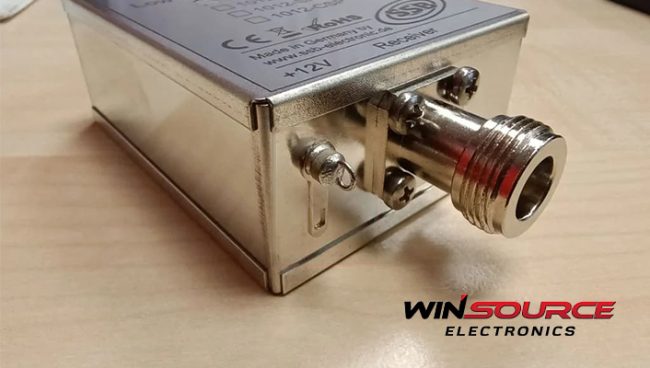
The Low-Noise Amplifier (LNA) balances the amplification of low-power signals without compromising their signal-to-noise ratio (SNR). Unlike typical amplifiers, an LNA is more subtle, meticulously minimizing additional noise by selecting specialized components, operating points, and circuit topologies.
This device is quite omnipresent in communication systems, medical instruments, and electronic test equipment, with the capability to supply a gain of 100 while diminishing the SNR by less than a factor of two. However, the LNA has many more features, making it an excellent choice for boosting weak signals and eliminating electric chatter.
Here’s everything you should know about it.
The Purpose and Definition of LNA
The primary purpose of an LNA is to enhance the signal strength while preserving its SNR, a key metric for signal quality. Contrary to traditional amplifiers, LNA’s design allows it to reduce the introduction of extra noise during the amplification process, ensuring that the desired signal remains robust in the face of amplification.
Moreover, LNA is a specialized amplifier typically used in communication systems, medical instruments, and electronic testing equipment. This device is beyond helpful in scenarios where weak signals, such as those received by antennas, demand a significant boost to overcome losses incurred during signal transmission.
But the LNA’s beauty lies in its ability to ensure equilibrium between various design goals, including power gain and impedance matching, while prioritizing the reduction of additional noise. That makes the amplified signal stronger and free from excessive noise interference.
LNA Key Features
One of the most significant LNA features is its ability to prioritize low noise figures, typically in the range of 1 dB, ensuring optimal signal-to-noise ratios. It also emphasizes linearity and enables the amplified signal to faithfully represent the input, even when more robust signals might induce distortion. This linearity contributes to the overall integrity of the signal chain, which is crucial for applications ranging from radio telescopes to wireless communication devices.
Another vital aspect of an LNA is its operating bandwidth, which determines the frequency range over which it can effectively amplify signals. A well-designed LNA offers a wide operating bandwidth, making it versatile across different frequency ranges commonly encountered in diverse communication systems.
The Most Common Applications of LNA
LNA is an indispensable component in applications that demand optimal signal reception and transmission. This flexible amplifier, designed for efficiency and precision, helps shape our interconnected world.
It ensures seamless signal reception and transmission. From cellular telephones to wireless local area networks (Wi-Fi), an LNA enhances the sensitivity of receivers, allowing them to pick up weak signals with clarity. Engineers also use this device for satellite communications systems to amplify the weak signals from distant satellites, overcome path loss, and deliver reliable communication.
For instance, radio telescopes leverage LNA’s capability to capture faint celestial signals. The sensitivity of this neat amplifier is crucial for discerning subtle signals from the vast cosmic expanse.
Besides, LNAs improve the performance of software-defined radio (SDR) receivers, providing the necessary boost to reception quality across different frequencies. In practical terms, the LNA translates to improved signal quality, extended communication ranges, and better data transmission in consumer electronics just as much as in sophisticated scientific instruments.
How to Choose an LNA
After understanding how an LNA relates to the specific requirements of your intended application, you’ll have an easier time choosing the right one. However, the following tips will help you streamline the search process and find the most compatible device.
Define Your Signal Requirements
Begin by clearly defining your signal specifications. Understand the frequency range, gain, and noise figure required for your application.
This step ensures that the chosen LNA aligns precisely with your signal processing needs.
Evaluate Gain and Noise Figure
Based on your application’s demands, hit the right spot between gain and noise figures. For instance, higher gain benefits weak signals, but it should come with a low noise figure to maintain signal integrity. Hence, you should carefully assess these parameters to optimize overall system performance.
Consider Linearity
Assess the LNA’s linearity, especially if your application involves handling larger signals. A linear amplifier ensures faithful signal representation even in the presence of stronger input signals, promoting the overall quality of the amplified output.
Account for Operating Bandwidth
Ensure the LNA’s operating bandwidth aligns with your application’s frequency requirements. A good match should enable the adequate amplification of signals within your specified frequency range.
Explore Impedance Matching
Understand your system’s impedance requirements and choose an LNA that facilitates seamless matching. This enhances power transfer efficiency, contributing to the overall amplifier effectiveness in your signal chain.
Learning about the key features, applications, and considerations when choosing and using an LNA allows you to make informed decisions that align with your specific requirements. Whether enhancing communication receivers or improving the performance of software-defined radio systems, the right LNA can be a game-changer.
Contact us for more information on how to choose and where to find an LNA compatible with your needs.
© 2025 Win Source Electronics. All rights reserved. This content is protected by copyright and may not be reproduced, distributed, transmitted, cached or otherwise used, except with the prior written permission of Win Source Electronics.

COMMENTS